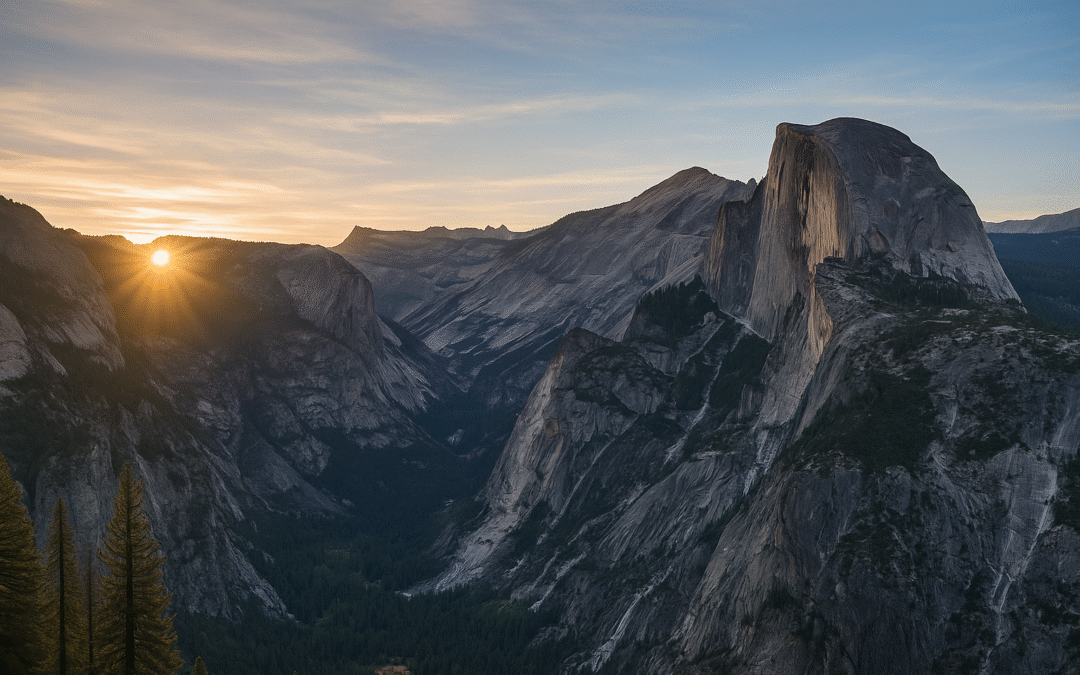
by Chuck Price | Oct 4, 2025 | Uncategorized
By Chuck Price. Reviewed by Angela Vance. Last updated: July 25, 2025
TL;DR: Your 2025 Yosemite Logistics Plan
Planning a 2025 Yosemite trip? The new “Peak-Hours-Plus” reservation system is just the beginning. This guide is a complete logistics toolkit. We provide a dynamic entry window spreadsheet to navigate the 6 am-2 pm permit times, a link to the real-time Wawona Road closure feed, and a custom RV parking map to find a spot for your rig. Don’t let outdated info derail your trip. This plan solves the three biggest hurdles for you. Read-time: 9 minutes.
What’s New in 2025: The Yosemite ‘Peak-Hours-Plus’ System
Just when you thought you understood the system, it changes. For 2025, Yosemite is implementing a “Peak-Hours-Plus” reservation system, required for any vehicle entering the park between 6 a.m. and 2 p.m. from May 24 through September 1, 2025. This is a critical shift from previous years. From my experience, these small tweaks in hours can dramatically alter your entire trip’s strategy, turning what was once a valid “early entry” plan into one that gets you turned away at the gate. This new system makes having a concrete, date-specific plan more important than ever.
Answer Capsule: For peak season 2025 (May 24–Sep 1), Yosemite requires a “Peak-Hours-Plus” reservation to enter the park by vehicle between 6 a.m. and 2 p.m.. You can enter before 6 a.m. or after 2 p.m. without a peak-hours reservation.
The Triple Threat: Why 2025 Is a Logistical Gauntlet
Getting a reservation is only the first hurdle. In 2025, visitors face a “triple threat” of logistical challenges. First, the reservation system itself. Second, major construction on key roads like the Wawona Road will cause significant delays and detours. Third, the infrastructure inside the park is strained. I’ve personally circled Yosemite Valley for an hour looking for a non-existent RV spot and felt the anxiety of having an electric vehicle with only two slow, occupied public chargers nearby. These three issues combined can ruin a trip if you arrive unprepared.
Answer Capsule: Visiting Yosemite in 2025 is uniquely challenging due to three overlapping issues: the new “Peak-Hours-Plus” reservation system, significant road construction closures, and a severe lack of both RV-friendly parking and EV-charging stations inside the park.
Your 2025 Yosemite Logistics Toolkit

Forget static advice. You need dynamic tools. Here is a three-part toolkit to navigate the 2025 season.
Tool 1: The Dynamic Entry Window Spreadsheet
The best time to arrive depends on your goals. This framework helps you decide.
Tool 2: The Real-Time Closure Feed
Construction, rockfalls, and weather can change your route instantly. Don’t rely on a blog post from last month. The only source of truth is the official NPS feed.
Tool 3: The RV & EV Parking Map
Standard vehicles struggle to find parking in Yosemite; for RVs and EVs, it’s even harder. Here is a map of the most viable spots.
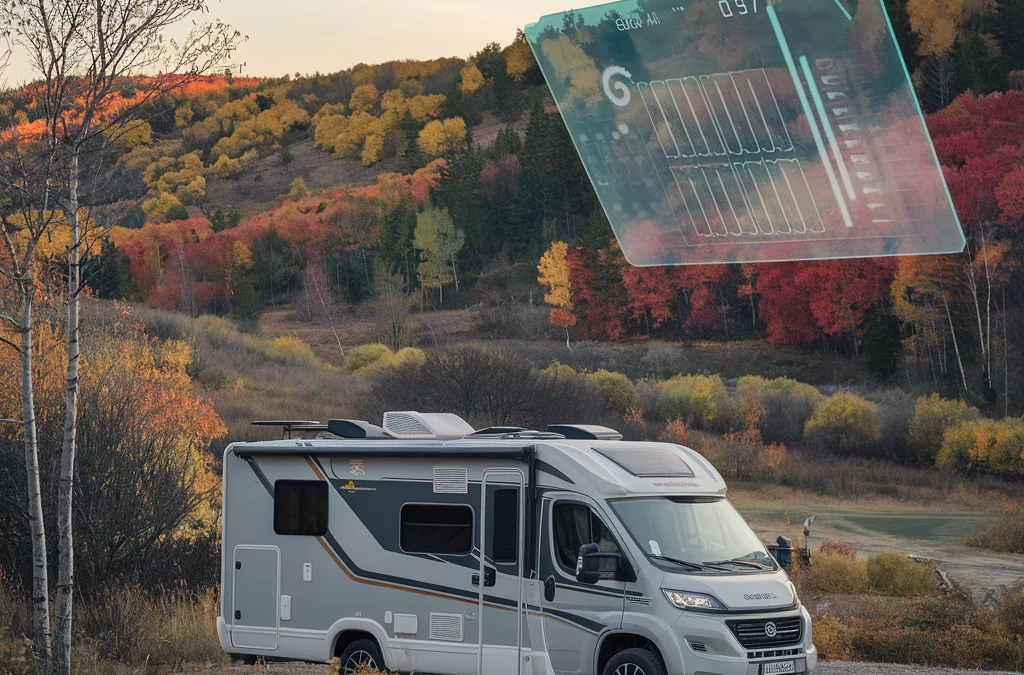
by Chuck Price | Oct 24, 2024 | Uncategorized
As fall approaches, RV enthusiasts are planning their next big adventure—chasing the vibrant colors of autumn and seeking the perfect boondocking spots off the beaten path. What if your trip could be more efficient, safer, and easier to plan than ever before? Thanks to the rise of artificial intelligence (AI), this is now a reality. AI-powered tools are reshaping RV travel, offering solutions that provide real-time insights to elevate the entire experience, particularly during fall when weather and crowd dynamics can be unpredictable.
Imagine setting out on your fall RV trip, not guided by paper maps or an outdated GPS system, but by intelligent AI that predicts peak foliage times, optimizes your fuel consumption, and suggests the best boondocking sites away from crowded fall festival areas. This is not just the future of travel—it’s happening now.
In 2024, AI tools are set to transform the travel industry, with a projected 30% increase in adoption across various platforms (McKinsey & Company, Travel Industry Report). This surge in AI isn’t just impacting how travelers book flights or hotels—it’s revolutionizing how RVers plan, navigate, and enjoy their trips, especially in the fall, when timing and conditions can make or break the experience.
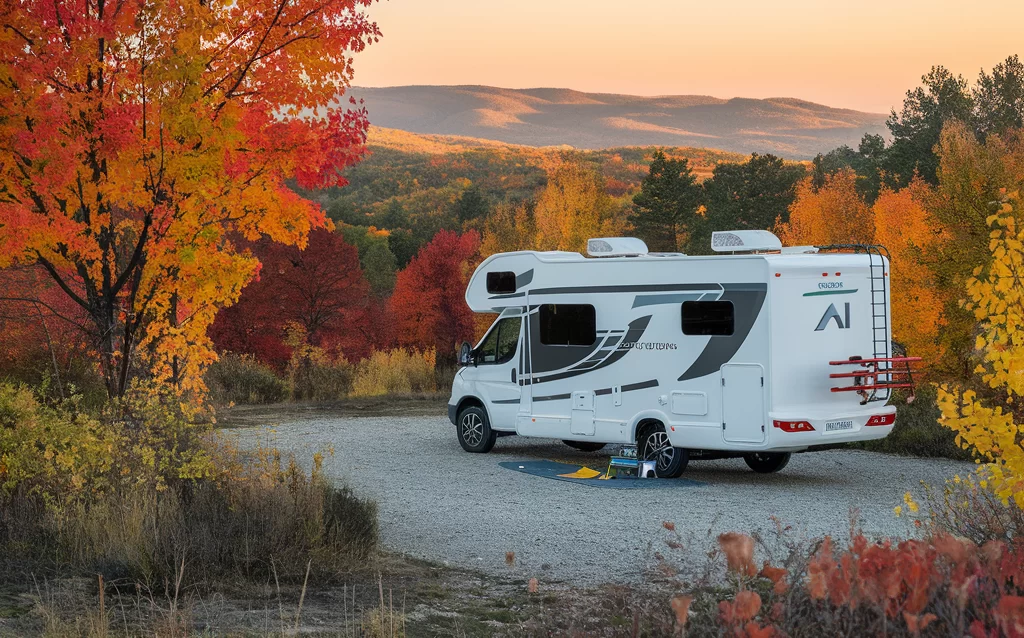
Optimizing Fall Foliage Adventures with AI
One of the most magical aspects of fall RV travel is witnessing the changing colors of leaves. But planning the perfect fall foliage tour requires precise timing and a bit of luck with the weather. Fortunately, AI tools can take much of the guesswork out of the process.
For example, apps like Foliage Finder and WeatherAI use predictive analytics to forecast the peak leaf-peeping times across popular regions. Whether you’re heading to the Smoky Mountains, Vermont’s Green Mountains, or New York’s Adirondacks, AI can help you adjust your route to hit the exact time when the foliage is at its most vibrant. These apps analyze historical weather patterns, current temperatures, and foliage reports to provide hyper-local forecasts.
Let’s say you’re planning a trip through New England in October. By using Foliage Finder, you can receive alerts when specific areas are expected to reach their foliage peak, allowing you to reroute your trip accordingly. Additionally, Roadtrippers can suggest scenic routes that maximize fall color views while avoiding overpopulated areas during peak tourist times.
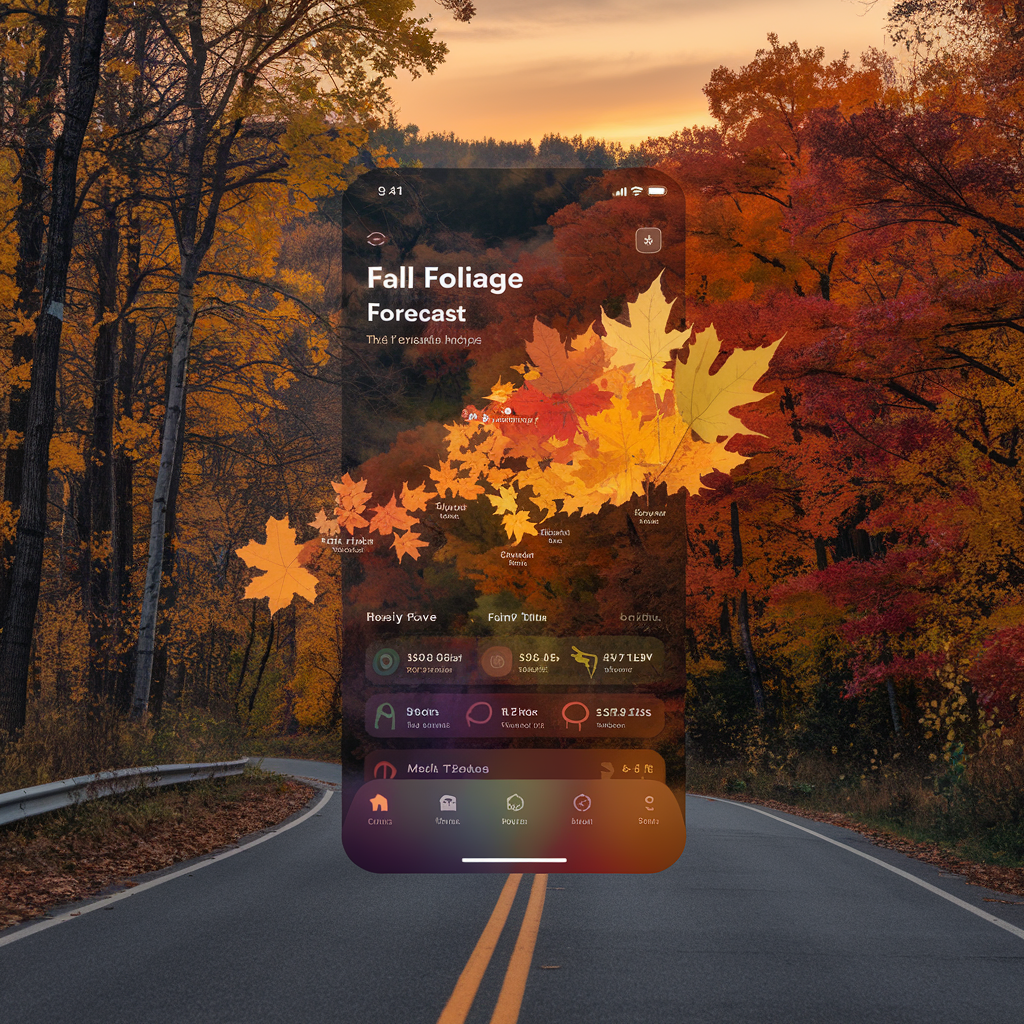
Fall-Specific Boondocking: AI Tools for Managing Colder Weather
Fall boondocking presents unique challenges, especially with the shift in temperatures and limited daylight hours. Managing resources like water and power becomes crucial, and AI tools are making it easier to stay off-grid longer without running into supply shortages.
AI-powered apps like MyTravelPal and Harvest Hosts allow RVers to filter boondocking spots based on important fall-specific factors, such as proximity to water refill stations or locations that get ample sunlight during the shorter fall days—perfect for those relying on solar power.
For example, when traveling through Utah’s national parks or Arizona’s desert landscapes in the fall, these apps can help you find boondocking locations that offer more sunlight or protection from colder temperatures, helping you extend your stay off-grid. iOverlander can provide real-time reviews from other travelers who have faced similar fall conditions, giving you practical insights into which locations offer the best balance of resources and scenic beauty.
Related Post:Best Ontario Parks for Late Fall RV Camping
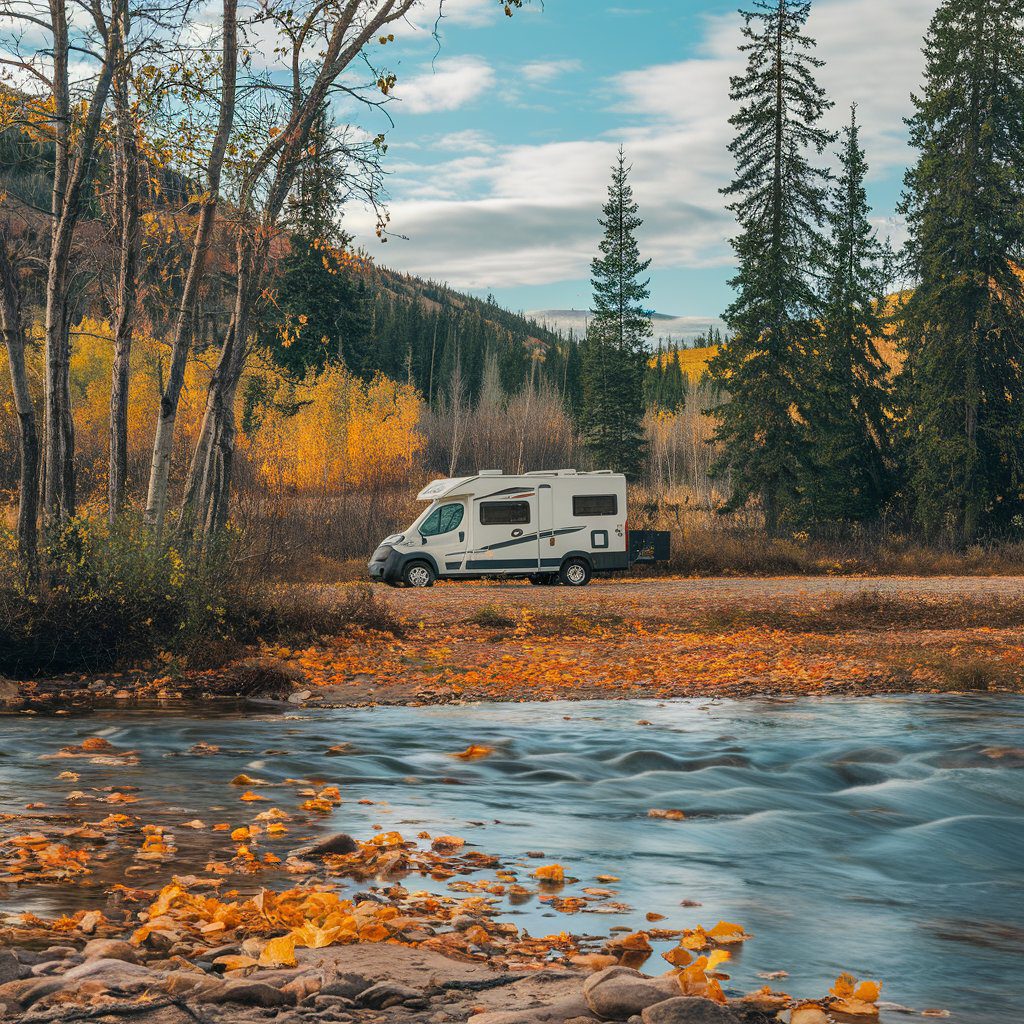
Safety First: Using AI to Avoid Fall Weather Hazards
Fall weather can be unpredictable, with sudden changes ranging from early snowstorms to wildfire risks in certain regions. Fortunately, AI tools offer real-time safety updates and hazard alerts, making it easier to avoid dangerous situations while on the road.
AI-powered apps like WeatherAI and Dark Sky provide hyper-local weather forecasts and alerts about sudden changes, such as high winds, snowfall, or heavy rain. For RVers planning to travel through mountain ranges like the Rockies or Sierra Nevada, these tools are invaluable. They help you plan safe routes, avoid getting caught in unexpected snowstorms, and suggest alternate routes based on real-time data.
Additionally, for those traveling through areas prone to wildfires, AI-driven apps like Caravan RV Parky can notify you of nearby fire risks or road closures due to smoke. These tools analyze satellite data, local news, and fire department reports to ensure you’re always informed of potential hazards before you reach your destination.
Related Post: 8 Most Dangerous National Parks in the US
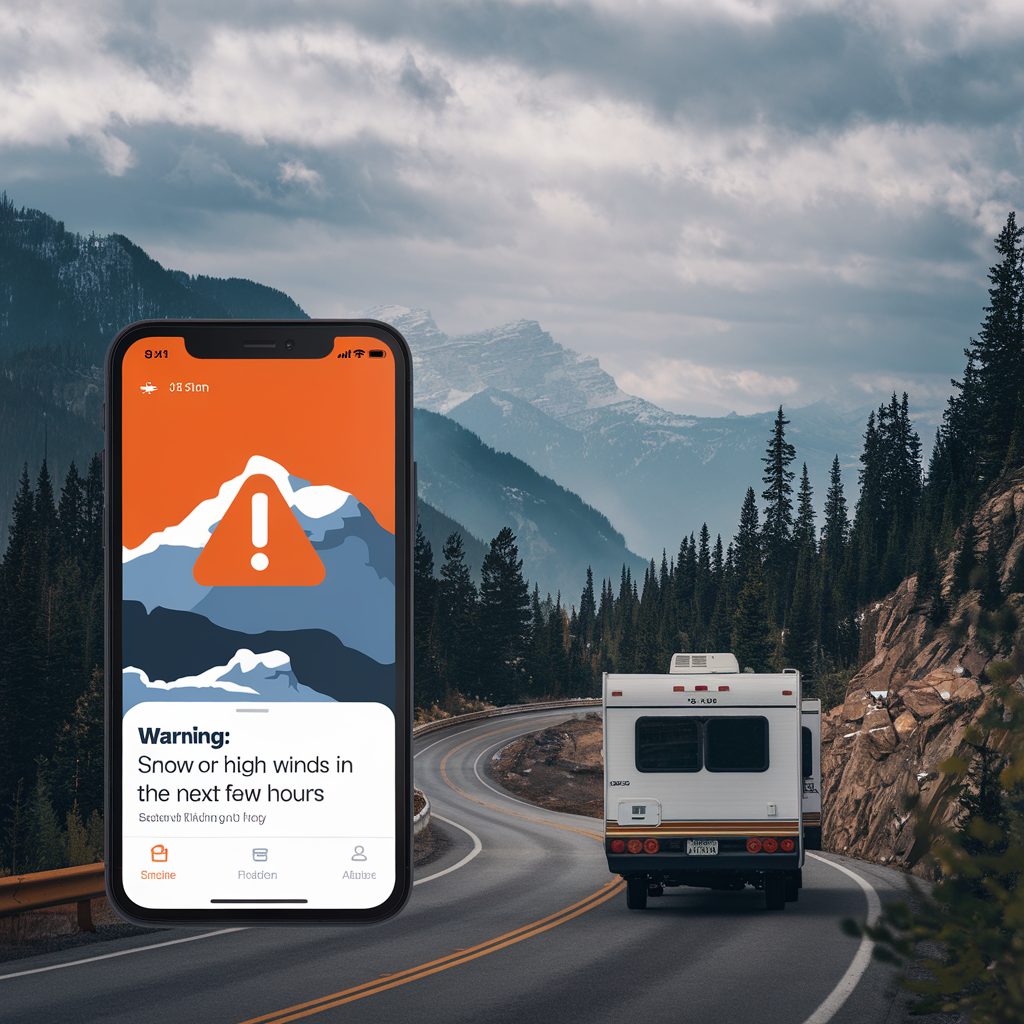
Practical Tips for Using AI in Fall RV Travel
To ensure you make the most of AI tools during your fall RV trip, here are some actionable tips for each stage of your journey:
- Planning the Perfect Fall Route
Use Roadtrippers or RV LIFE Pro to map out scenic routes known for stunning fall foliage. These apps allow you to adjust your path based on peak foliage forecasts, ensuring you see the best colors.
- Saving on Fuel with AI
Before hitting the road, use GasBuddy to find the cheapest fuel stations along your route. Pair this with Waze for optimized routing based on fuel efficiency, avoiding steep inclines or unnecessary detours.
- Example: If traveling through the Blue Ridge Parkway, use Waze to avoid high-traffic areas and reduce fuel consumption on winding mountain roads.
- Maximizing Boondocking Resources
For off-grid camping, apps like Harvest Hosts and MyTravelPal allow you to find boondocking sites that offer better solar exposure and proximity to resource stations.
- Example: Boondocking in New Mexico? Use Harvest Hosts to find a winery or farm that offers free stays, complete with accessible water and power resources for longer stays.
- Staying Safe with Real-Time Alerts
Always keep WeatherAI or Dark Sky active for hyper-local weather alerts, especially in regions prone to sudden temperature drops or storms.
- Example: When traveling through Montana, use WeatherAI to monitor early snowfall alerts, ensuring you reroute or find a sheltered spot before the storm hits.
Related Post:The Ultimate Guide to BLM Camping: Exploring America’s Public Lands
Comparing AI-Powered Travel Apps for Fall RV Adventures
| App |
Key Features |
Best For |
| Roadtrippers |
Route planning, scenic detours, personalized trip suggestions, multi-stop itineraries |
Planning scenic routes and exploring off-the-beaten-path destinations |
| GasBuddy |
Find lowest fuel prices, real-time gas price updates, fuel station reviews |
Budget-conscious travelers looking to save on fuel |
| iOverlander |
Boondocking and camping spot listings, traveler reviews, GPS navigation |
Off-grid RVers seeking crowd-free locations and boondocking tips |
| RV LIFE Pro |
RV-friendly routes, height clearance warnings, multi-destination trip planning |
Comprehensive trip planning for RVers, especially for long-distance routes |
Related Post: Best Multi-Stop Routing Apps for RV Travelers and Road Trip Planning
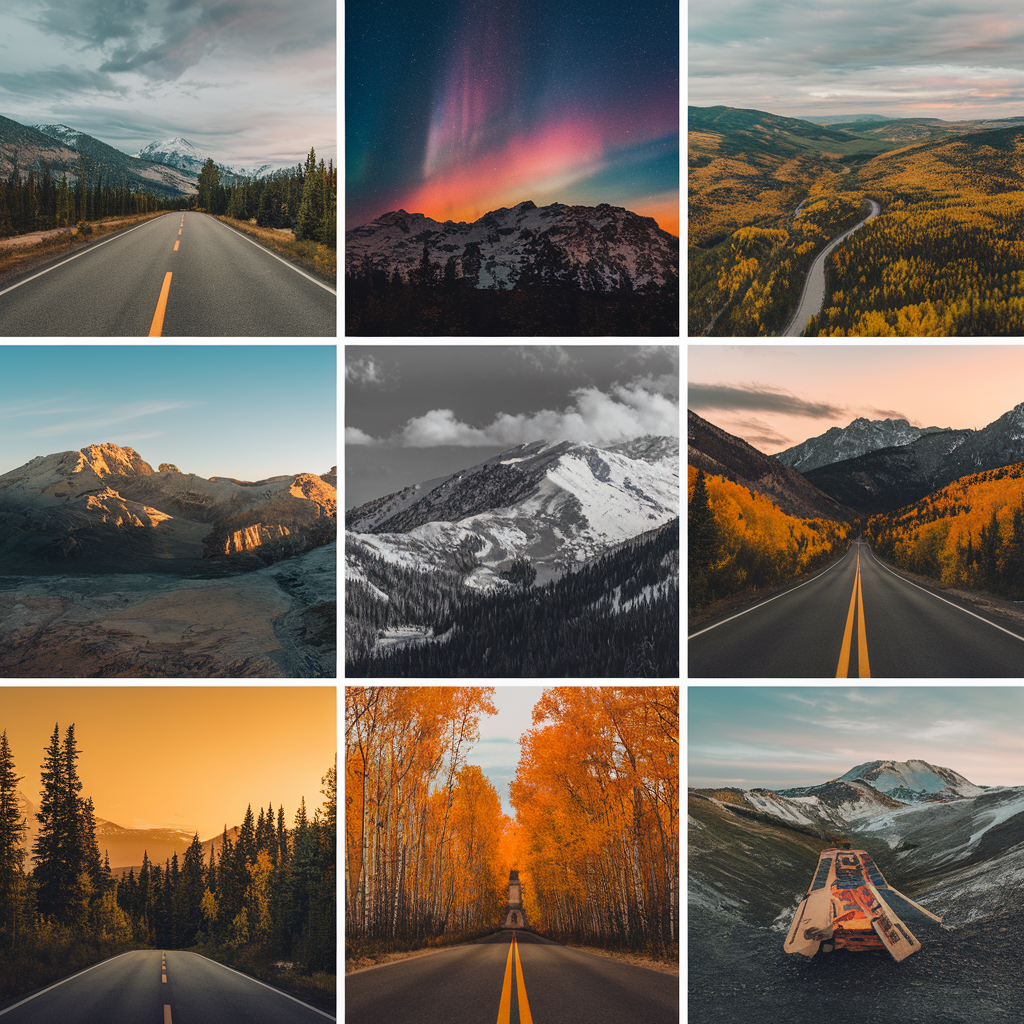
Join the Conversation: Your AI-Enhanced Fall RV Adventure
At BoondockorBust.com, we’re always eager to hear from our readers. Have you used AI tools to plan your fall RV trips? Whether it’s navigating scenic routes or finding the best boondocking spots, we’d love to know which apps have been the most helpful for your adventures. Share your tips, stories, and favorite tools in the comments below to help other RVers make the most of their fall travels.
Here’s what some of our readers have said about using AI on their fall RV journeys:
Jana A, Full-Time RVer
“My husband and I are full time RVers in a 45ft 5th wheel toy hauler. I use RV Trip Wizard to plan our route. It has made my trip planning so much easier since I can filter out campgrounds that cannot accommodate our trailer. The ability to check reviews and to go to the campgrounds’ websites from the app is also extremely useful. I recommend RV Trip Wizard to other RVers all the time.”
Public-Bake-3273 via Reddit
“Roadtrippers is for me 100% useless….. it’s for planing trips but I am not planing my trips. I am looking only for the next disperse camping spot.”
Klutzy-Dog4177 via Reddit
“We have the RV life pro for $65 per year. We have been full-time traveling for 3 years. The trip wizard is definitely worth it. We use a lot of military fam camps, and they show up on the map (they don’t show on most maps, even Google). The ability to download maps for when you have no signal has come in handy as well.”
Take Your Fall RV Adventure to the Next Level
Looking to make your next fall RV trip even better? Visit our RV Travel Resources for the best tools, tips, and reviews on AI-powered apps that can help you plan, navigate, and enjoy your journey with ease.
Want more RV travel tips and insights on how to use AI for your adventures? Subscribe to our newsletter for expert advice, exclusive content, and seasonal updates, delivered right to your inbox!
Conclusion: AI’s Role in Elevating Fall RV Travel
As we’ve explored, artificial intelligence is not just a futuristic concept for RV travel—it’s already here, transforming how RVers plan, navigate, and enjoy their trips. From optimizing routes and predicting peak fall foliage times to avoiding unexpected weather hazards, AI is making RV travel smarter, safer, and more efficient, particularly during the unpredictable fall season.
By combining AI tools with user-generated content, RVers can enhance their travel experiences and tackle the unique challenges of fall adventures. Whether it’s finding the perfect leaf-peeping route or avoiding sudden weather changes, AI is an essential tool for any modern RVer.
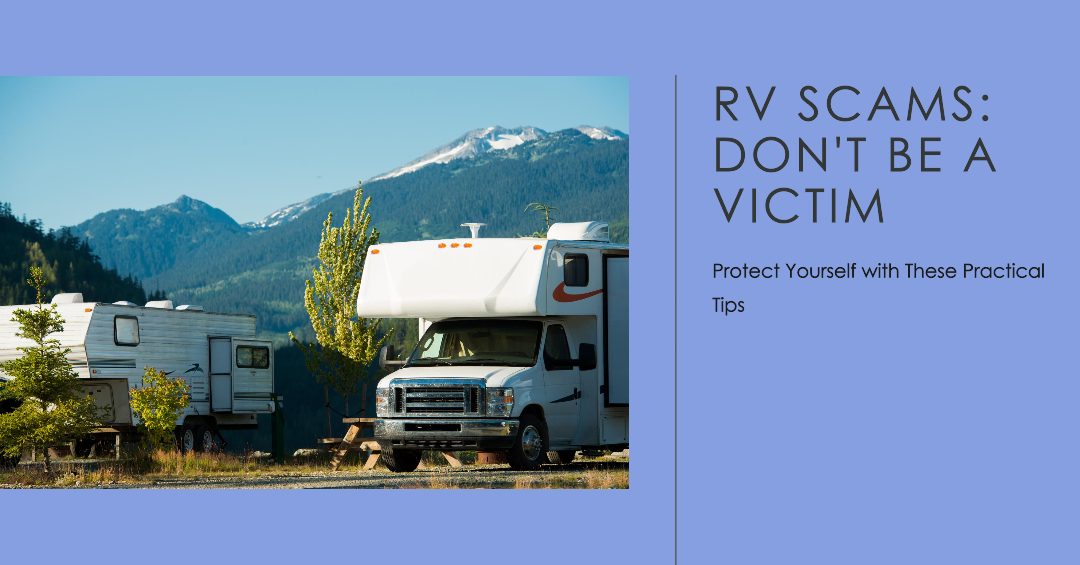
by Chuck Price | Aug 11, 2024 | Uncategorized
The Rising Threat of RV Scams
Owning an RV offers freedom and adventure, but the excitement can be overshadowed by the growing threat of scams. According to the Federal Trade Commission (FTC), scams targeting high-value items like RVs are on the rise, with victims reporting average losses of around $1,000—though the actual cost can be much higher. This article sheds light on the issue by sharing real-life experiences, providing practical tips to avoid becoming a victim, and offering valuable resources for staying safe.
Common RV Scams to Watch Out For
The world of RV ownership is unfortunately rife with scams. Here are some common tactics used by scammers:
Online Scams
- Fake Customer Support: Scammers create convincing fake websites or pop-ups that direct users to fraudulent support numbers, often charging hefty fees for nonexistent services. Learn more about how to identify and avoid phishing scams.
- Phishing and Fake Websites: These scams involve tricking RV owners into revealing personal information through deceptive emails, websites, or text messages. The FTC’s guidelines on identity theft provide crucial advice on how to protect your personal information.
- Questionable Online Listings: Scammers post fake RV listings with disabled comments to avoid detection and lure potential buyers into fraudulent transactions. For more details on recognizing online scams, visit the FTC’s consumer advice page.
Repair Scams
False Repair Claims: Scammers use fear tactics and fabricated evidence to convince RV owners that their vehicles require unnecessary repairs, often at inflated prices. The FTC Office of Inspector General provides insight into how to report these scams and protect yourself from becoming a victim.
Sales Scams
Suspicious Sales Offers: Scammers may offer to buy your RV sight unseen, using unusual language and pressure tactics to quickly finalize the deal. The FTC’s fraud reporting platform offers a streamlined way to report such scams and get assistance.
By understanding these common scams, you can take steps to protect yourself and your investment.
How to Protect Yourself from RV Scams
Safeguarding your RV investment requires vigilance and knowledge. Here are essential steps to protect yourself:
- Verify Information Thoroughly: Always double-check support numbers, product listings, and sales offers using official channels. The Consumer Financial Protection Bureau (CFPB) offers guidance on verifying the legitimacy of offers.
- Seek Expert Opinions: When faced with unexpected repair claims, consult a trusted RV mechanic for a second opinion. The FTC advises always getting a second opinion before committing to costly repairs.
- Prioritize In-Person Transactions: Avoid buying or selling RVs without a thorough in-person inspection. The FTC’s advice on avoiding online scams emphasizes the importance of in-person verification.
- Conduct Thorough Research: Investigate both products and sellers online, paying close attention to reviews and feedback. Learn more about how to research potential sellers from the FTC’s phishing scam guidelines.
- Approach Giveaways with Caution: Verify the legitimacy of any giveaway before providing personal information. The FTC provides tips on how to avoid scams that often accompany giveaway offers.
- Enhance Online Security: Enable two-factor authentication on all online accounts for added protection. The FTC’s online security resources can help you set up stronger defenses.
- Monitor Financial Accounts Closely: Regularly review bank and credit card statements for unauthorized charges. The FTC’s identity theft resources provide advice on monitoring accounts for suspicious activity.
- Consider Credit Monitoring: Explore credit monitoring services to detect suspicious activity early. The FTC recommends using credit monitoring as a proactive measure against fraud.
- Educate Yourself and Others: Learn about common social engineering tactics and share this knowledge with family and friends. The FTC’s consumer education blog offers ongoing updates on how to recognize and avoid scams.
Expert Insights on Avoiding RV Scams
Industry experts and consumer protection agencies offer valuable advice:
- Verification of Sources: It’s crucial to verify the source of any communication, such as support calls or emails, as scammers are becoming increasingly sophisticated. Always double-check details, such as URLs and phone numbers, to avoid falling victim to scams.
- Sophisticated Scams: Oana Schneider from the Tri-State Better Business Bureau highlights that scammers are aware of what potential buyers are looking for and can create sophisticated scams to exploit this knowledge, particularly with fake websites and phishing attempts.
- Too Good to Be True Offers: Be cautious of offers that seem too good to be true. Scammers often prey on people’s desires for a great deal. This advice is echoed in various RV buying guides, which caution against deals that seem unusually favorable.
- Research and Verification: The Better Business Bureau recommends researching the seller and verifying their information, such as website creation dates, contact details, and business authenticity, to avoid falling for online RV scams.
Consumer Protection Advice
“Report any suspicious activity to authorities immediately. The sooner a scam is reported, the better the chances of preventing further victims.”
The Federal Trade Commission’s Bureau of Consumer Protection advises reporting any suspicious activity to help prevent others from falling victim to similar scams. They stress the importance of researching sellers and verifying the legitimacy of websites before making any purchase. For additional guidance, you can also report scams to the FBI, which plays a crucial role in investigating and addressing fraud-related crimes.
Real-Life Case Studies of RV Scams
- The Craigslist Bargain: In San Antonio, scammers posted fake listings for a 2003 Dutchmen Classic RV priced at only $1,200. The ad claimed the RV had new tires, a new mattress, and was “ready to camp.” This extremely low price for a seemingly well-maintained RV was a red flag for a scam.
- The eBay Gift Card Scam: In April 2019, a New Braunfels woman thought she was buying a Nissan Maxima for $1,200 through an eBay listing. The scammer provided a fake eBay invoice and convinced her to pay using eBay gift cards. Once she gave the gift card codes to the “seller,” her money was gone.
- The Military Deployment Ruse: A potential buyer encountered a listing for an RV at an unbelievably low price. The seller claimed to be in the military, about to be deployed, and unable to show the vehicle in person. This is a common script used by scammers to explain why they can’t meet in person and why the price is so low.
- The Family Tragedy Ploy: One scammer, using the name Jessica, responded to an inquiry about an RV listing by claiming her husband had died two months ago and she had moved back to her hometown. This emotional appeal was used to justify the low price and rush the sale.
These case studies highlight common red flags, including unrealistically low prices, pressure to use unconventional payment methods, and the inability of the seller to meet in person. By understanding these tactics, you can protect yourself from becoming the next victim.
Prevention Strategies for RV Owners
Protecting yourself from RV scams requires a proactive approach. Consider these essential prevention strategies:
- Verify the Legitimacy of Customer Support
- Use official contact information provided directly by the RV manufacturer or dealer. You can learn more about identifying legitimate contact details from the FTC’s guide on avoiding phishing scams.
- Carefully inspect website addresses for misspellings or unusual domains. The FBI’s internet safety tips offer advice on spotting fraudulent websites.
- Be cautious of unsolicited support offers, especially those appearing as pop-ups or in emails. Refer to the FTC’s advice on recognizing scams for more details.
- Protect Personal Information
- Never share sensitive data like Social Security numbers, bank details, or passwords unless certain of the recipient’s identity. The FTC provides guidance on how to safeguard your personal information.
- Use secure channels (indicated by “https://” and a padlock icon) when sharing sensitive information. More on secure communication can be found on the FTC’s online privacy page.
- Recognize Common Scam Tactics
- Be cautious of overpayment scams involving refund requests. The FTC’s phishing scam guidelines cover common tactics used by scammers.
- Stick to traditional payment methods like bank transfers or cash, avoiding requests for gift cards or cryptocurrency. The FTC’s warning on gift card scams is essential reading.
- Conduct Thorough Research
- Check reviews and feedback on companies and individuals involved in RV transactions. The Better Business Bureau’s Scam Tracker is a valuable tool for researching businesses.
- Request vehicle history reports and other relevant documents to verify the RV’s condition and ownership. For more tips, visit the FTC’s guide on buying vehicles.
- Insist on In-Person Transactions
- Conduct transactions face-to-face whenever possible to inspect the RV and build trust. The FTC’s advice on avoiding online scams is a helpful reference.
- Choose safe meeting locations like police station parking lots. The FTC suggests using secure locations for all in-person transactions.
- Report Suspicious Activity
By following these preventative measures, you can significantly reduce your risk of falling victim to RV scams.
Resources, Additional Tips, and Next Steps
If you believe you’ve been a victim of an RV scam, or if you encounter suspicious activity, contact these organizations:
- Federal Trade Commission (FTC): Report scams and get valuable advice on protecting yourself.
- Better Business Bureau (BBB): Check business reputations and report fraudulent activities.
- Consumer Financial Protection Bureau (CFPB): Seek resources and support for dealing with financial scams.
Additional Tips for Protecting Personal Information
Online Protection:
Offline Protection:
- Shred sensitive documents before discarding them. The FTC recommends shredding documents that contain personal information to prevent identity theft.
- Exercise caution when sharing personal information over the phone. Review tips on avoiding phone scams from the FTC.
What to Do If You Believe You’ve Been a Victim of an RV Scam
If you suspect you’ve fallen victim to an RV scam, take immediate action:
- Contact Your Bank: Notify your bank or credit card company immediately to prevent further unauthorized transactions. The Consumer Financial Protection Bureau (CFPB) offers advice on how to handle fraud.
- Report the Scam: File a report with the Federal Trade Commission (FTC) and the Better Business Bureau (BBB) to help stop the scammers and protect others.
- Monitor Your Accounts: Keep a close eye on your financial accounts for any suspicious activity. For more on monitoring your accounts, visit the FTC’s Identity Theft resource.
- Protect Your Accounts: Change passwords for all affected accounts to prevent further access. The FTC provides guidelines on securing your accounts.
Call to Action
Your experiences can help others avoid falling victim to RV scams. Share your stories and insights in the comments below. By working together, we can create a safer environment for RV enthusiasts.
Legal Disclaimer
The information provided in this article is for general knowledge and informational purposes only. It does not constitute legal or financial advice. Readers are encouraged to consult with a qualified professional for advice tailored to their specific circumstances.









